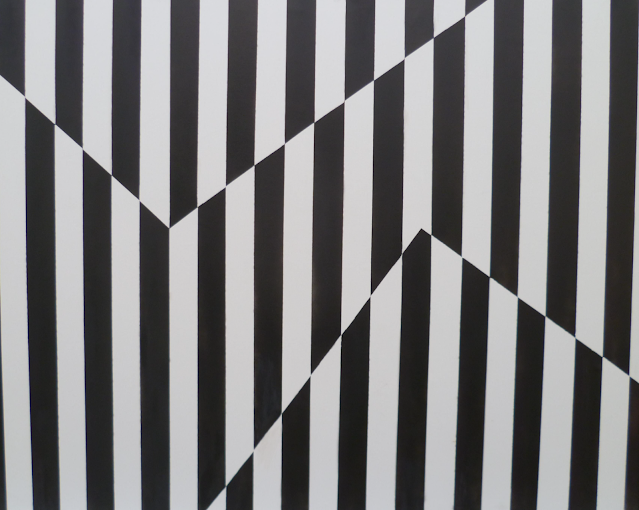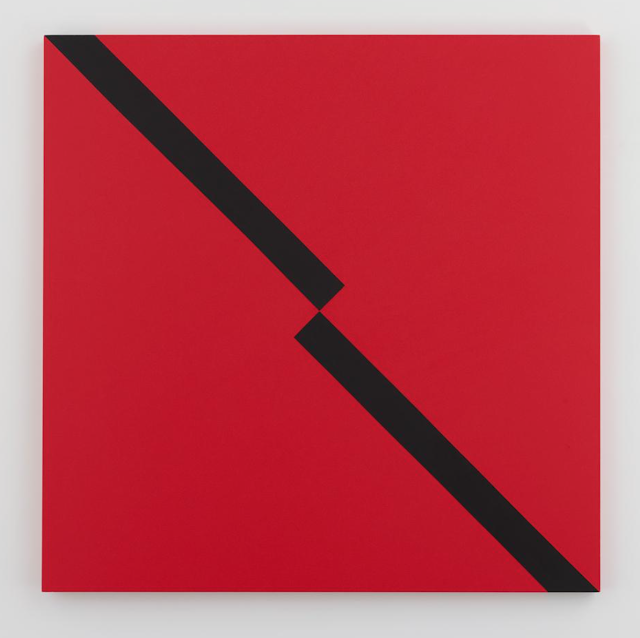Carmen Herrera
is a Cuban-American abstract, minimalist visual artist and painter. She was born in Havana and has lived in New York City since the mid0195s. Herrera's abstract works have brought her international recognition late in life.
Style and Progression
The key to understanding Carmen Herrera's style is remembering that, before she left Cuba, she was trained as an architect. According to Herrera, her optical and minimalist approach to form illustrates her "quest... for the simplest of pictorial resolutions."
"This foundation can be seen in her urge to use measurements and tools to create orderly art in a chaotic world. In an article for the New York Times, critic Ted Loos succinctly captures the essence of Carmen Herrera's work, as characterized by "signature bold simplicity: sharply delineated blocks of color often energized by a strong diagonal line. " In her own words, Herrera thinks about "the line, the paper, about a lot of tiny things that get bigger and bigger... and then a picture comes up." she is also a self-professed believer in the adage that "less is more" and paints with her brain rather than her heart. This drives her to consider not only whether she likes a color, but also what it doesn to the other colors involved and whether she can reduce an aspect of her work to improve it.
Creative Process
Herrera's creative process is relatively straightforward and orderly, as one might expect given her professional training. Step one, she sketches with a pencil and graph paper while sitting beside a long bank of windows looking out over E 19th St. This process begins by 9:30 every morning. Step 2, she "transfers the idea to a small piece of vellum, and, using acrylic paint markers, does the sketch in color." Then comes a larger iteration of the work to make sure her initial concept still translates. If it meets her approval, she proceeds to have her assistant, Manuel Belduma, map out the lines with tape on canvas under her exacting gaze.
Then the painting process can begin Typically, she will put on the first coat and Belduma applies subsequent layers. Once complete, the art is placed around the studio for her consideration, and even then she will sometimes scrap it and go back to the drawing board in pursuit of simplicity. In addition to providing a capable set of hands, Belduma is also responsible for gathering materials and helping her with day-to-day studio operations. He is an often-overlooked contributing factor to Herrera's artistic process.
Work
While some of her work has drawn comparisons to Brazilian neo-concretists Lygia Clark and Hélio Oiticica, according to the renowned New York critic Karen Rosenberg, Carmen Herrera's style is defined by her "signature geometric abstractions." She presents "pared-down paintings of just two colors [that contain] seemingly infinite spatial complications." These sensibilities were initially developed during her six years stint in post WWII Paris, where she encountered the ideas of artists like Kazimir Malevich, Piet Mondrian, and other devotees of Suprematism and De Stijl. She is not only significant for her contributions to geometric abstraction; many of her works are also complex representations of the natural world. For example, her seminal twelve-year series Blanco y Verde (1959) is a deconstruction of traditional landscape painting. First, she utilizes horizontal lines to create a sense of horizon. This sense is then heightened by her signature diagonal line, which combines to create the traditional focal point that is a hallmark of many landscapes. The deliberate contrast of white on green also captures the essence of many landscape color-schemes in a very abstract sense.
Another notable facet of Carmen Herrera's early development was her experimentation with canvas shape. Sara Rich, a Pennsylvania State University professor specializing in the connection between American Abstraction and the visual culture of the Cold War, explains that Herrera's earliest works focused primarily on orienting the canvas appropriately to reflect its shape. In the beginning, Rich contends, Herrera was essentially concerned with reminding audiences that, for example, a circular canvas, in the real world, "wanted to roll." She mainly tried to achieve this by employing arrows and other similarly shaped directional devices. This exploration led her to consider triangles and the motion indicated by painted marks continuing off of the canvas and around its edge. Herrera is notable for consistently manipulating the effect that triangles often have in paintings, which is providing context and perspective that takes away from a works abstraction. Sara Rich also notes that Barnett Newman was also an early friend and extremely formative influence on the young Herrera's works after she left Cuba in 1939.
Late-life discovery
Carmen Herrera was not broadly recognized or appreciated for decades, selling her first piece of artwork at 89 years old. Prior to her recent shows at the Lisson Gallery and Whitney Museum, she had only one major show in 1984 at the now defunct Alternative Museum in New York. As Karen Rosenberg Noted, Herrera's first solo art exhibition came over fifty years after she first moved to New York, where she has been since 1954. This is primarily a result of dominant attitudes towards women in art and Cubans in America, which both constitute hurdles she has overcome throughout her career. All of this finally changed for Herrera in 2004.
Herrera exhibited several times at the Salon des Réalités Nouvelles beginning in 1949. Solo exhibitions were hosted at the Galeria Sudamericana (1956), Trabia Gallery (1963), Cisneros Gallery (1965) and Alternative Gallery (1986). El Museo del Barrio in East Harlem, New York, mounted Carmen Herrera: The Black and White Paintings, 1951-1989, an exhibition of Herrera's work in 1998.
Due to her inability to walk, Herrera now lives at home full-time with caretakers who tend to her. She receives artistic input and critique from her close friend and neighbor, Tony Bechara. Manuel Belduma continues to aid her.
Herrera has remarked that it is the "Beauty of the straight line" that keeps her going.


































Comments
Post a Comment